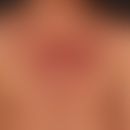Synonym(s)
HistoryThis section has been translated automatically.
DefinitionThis section has been translated automatically.
Rare, acute or subacute maximum variant of rosacea with acne conglobata-like progression (previously known as pyoderma faciale - O'Leary), which occurs predominantly in women.
You might also be interested in
Occurrence/EpidemiologyThis section has been translated automatically.
Very rare clinical picture; epidemiological data are not available.
ManifestationThis section has been translated automatically.
w>m; 20-30 years; often occurring during pregnancy
ClinicThis section has been translated automatically.
Acute to peracute, inflammatory papulo-pustules, fluctuating nodules appear within a few days or weeks. The picture resembles acne conglobata (typically in young men), but the comedones typical of acne are absent. The highly acute course with a tendency to fusion of the nodules with fistula formations is typical. In contrast to acne conglobata, systemic signs such as malaise, fever, arthralgias are absent.
Associations with Crohn's disease have been described.
HistologyThis section has been translated automatically.
Dense perifollicular and perivascular inflammatory infiltrate of neutrophil and eosinophilic granulocytes, also plasma cells and multinuclear giant cells, penetrating the entire dermis.
Differential diagnosisThis section has been translated automatically.
External therapyThis section has been translated automatically.
Avoidance of irritating substances, no soaps, syndets or alcoholic tinctures. Antibiotic-containing externals such as erythromycin (e.g. Eryaknen) or tetracycline are as effective as 2% ketoconazole cream (Terzolin) or azelaic acid (e.g. Skinoren). In addition, the external application of a 1% metronidazole cream has proved successful.
For covering, preparations with sodium bituminosulfonate (e.g. Aknichtol Soft) or ichthyol mixed paste for the night are suitable (see formulations).
Internal therapyThis section has been translated automatically.
Good therapeutic successes are achieved with isotretinoin (e.g. acnenormin 0.5-1 mg/kgkgkg/day).
Alternative long-term therapy trial with tetracyclines p.o. (e.g. Tefilin) 1.0-1.5 g/day spread over 3 ED or doxycycline (e.g. Supracycline) 2 times/day 100 mg p.o.
Alternatively minocycline (e.g. clinomycin) 50-100 mg/day. Duration of therapy usually over several weeks is indicated. Tetracyclines are the drug of first choice for ophthalmologic involvement.
Alternatively: In the case of pronounced inflammatory symptoms, short-term trials with glucocorticoids in low doses such as prednisone (e.g. Decortin) 20-40 mg/day for 2-3 weeks, gradual dose reduction according to the clinic.
Note(s)This section has been translated automatically.
It can be assumed that the pyoderma faciale and rosacea conglobata and rosacea fulminans are identical clinical pictures.
LiteratureThis section has been translated automatically.
- Akhyani M et al (2007) The association of pyoderma faciale and erythema nodosum. Clin Exp Dermatol 32:275-277
- Coutinho JC et al (2016) Rosacea fulminans: unusual clinical presentation of rosacea. An Bras Dermatol 91(5 suppl 1):151-153.
- Dessoukey MW et al (1996) Pyoderma faciale: manifestation of inflammatory bowel disease. Int J Dermatol 35:724-726
- Dobson CM, Parslew RA, Evans S. (2003) Superficial granulomatous pyoderma treated with intravenous immunoglobulin. J Am Acad Dermatol 48: 456-460
- Fender AB et al (2008) Pyoderma faciale. Cutis 81:488-490
- Jansen T, Plewig G, Kligman AM (1994) Diagnosis and treatment of rosacea fulminans. Dermatology 188: 251-254
- Leyden JJ (1997) Therapy for acne vulgaris. N Engl J Med 336: 1156-1162
- O'Leary PA, Kierland RR (1940) Pyoderma faciale. Arch Dermatol Syphilol 41: 451-462
- Ormond P, Rogers S. (2003) Pyoderma faciale (PF) (rosacea fulminans). Clin Exp Dermatol 28: 107-108
- Plewig G, Jansen T, Kligman AM (1992) Pyoderma faciale. A review and report of 20 additional cases: is it rosacea? Arch Dermatol 128: 1611-1617
- Razeghi S et al (2013) Successful treatment of localized pyoderma faciale in a patient with Crohn's disease. Gastroenterol Hepatol (N Y) 9:541-543
Incoming links (4)
Facial pyoderma; Facial swelling, differential diagnosis; Myelodysplastic syndromes and skin; SIBO Syndrome;Outgoing links (6)
Acne conglobata; Acne fulminans; Bromoderm; Folliculitis gramnegative; Iododerma tuberosum; Rosacea;Disclaimer
Please ask your physician for a reliable diagnosis. This website is only meant as a reference.






